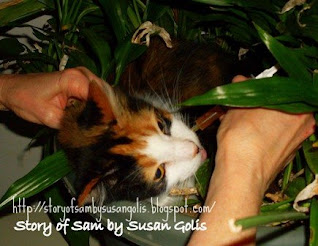Four of my housecats had symptoms of a cold which rapidly turned into an upper respiratory infection.
Their symptoms were sneezing, water eyes and nasal drainage with no appetite and refusal to drink water. The day before their cold like symptoms all cats drank a lot of water and slept more and they hid under the bed, sofa and in the closet.
I responded to their symptoms quickly and the first thing that I did was isolate them in one room and added an air purifier to the room to remove 99.9 percent of the airborne germs.
I then called my veterinarian and they saw the cats immediately. The cats were treated with the antibiotic Doxycycline.
Their symptoms were sneezing, water eyes and nasal drainage with no appetite and refusal to drink water. The day before their cold like symptoms all cats drank a lot of water and slept more and they hid under the bed, sofa and in the closet.
I responded to their symptoms quickly and the first thing that I did was isolate them in one room and added an air purifier to the room to remove 99.9 percent of the airborne germs.
I then called my veterinarian and they saw the cats immediately. The cats were treated with the antibiotic Doxycycline.
Treatment:
- Doxycycline was administered to the cats with syringe without needle. Best way is to put the syringe in the side of the cats mouth and release the liquid slowly. (Follow dosage instructions given by your veterinarian)
- Lysine powder: (follow dosage instructions by your veterinarian) mix the lysine with can cat food once per day for 30 days. Or buy the cat chewable tabs for cats. (The chewable tabs are easier to administer to the cats)
- Feed high quality food: I am feeding all of the cats Blue Buffalo can spa select. It has a good source of antioxidants that will boost cats immune system.
- To help the cat’s breath better run hot water into the tub and allowing the room to fill with steam. Put your sick cat in the bathroom for 20 minutes. The steam aids in opening up the nasal passages. This of course is helpful because the cat can then smell his food.
- Wipe the cat’s nose with a cotton ball that is moistened with warm water, this will remove the excess nasal drainage and allow the cat to smell.
- To entice the cat to eat add three tablespoons of filtered water to a microwave safe plate or shallow bowl. Then add one tablespoon of the canned cat food and heat for 10 seconds. The warm food has a strong aroma and the cat can smell it and will then eat.
- If the cat refuses to eat use a feeding syringe without needle and fill it with the watered down canned food. Feed the cat slowly from the side of their mouth.
- Keep cats hydrated. My cats refused to drink so my husband and I administered filtered water by way of a syringe. We were up a few nights caring for them so that they would stay hydrated and nourished.
- To prevent the spreading of germs wear a ventilator mask, latex gloves and spray your clothing with Lysol disinfectant spray.
All cats were up to date with vaccines.
What I learned is vaccines will help prevent many strains of viruses but they do not prevent all of them. It is like a human getting a flu shot.
What I learned is vaccines will help prevent many strains of viruses but they do not prevent all of them. It is like a human getting a flu shot.
With antibiotic treatment and the administering of syringe hydration and nourishment all of the cats showed signs of improvement within three days and were completely healed within 10 days.
Cats hide when they are ill because it protects them from being attacked, this is nature. When cats are sick it is a sign of weakness. Cats will hide until they can hide no more.
I recommend Lysine for cats as this enzyme will help to prevent virus symptoms.
















